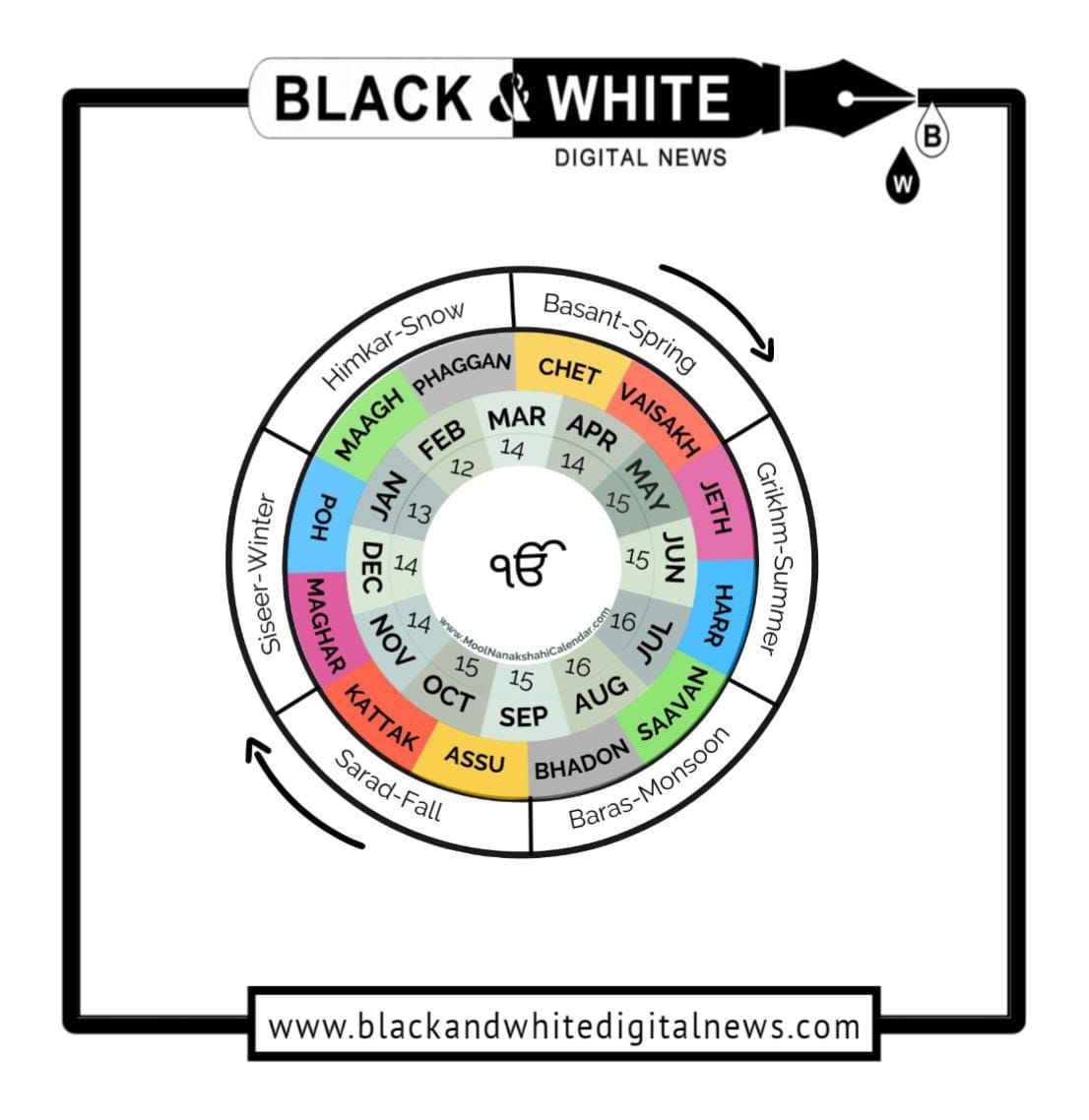Parkash Purab of Sri Guru Gobind Singh Ji: Unraveling the Sikh Calendar Controversy
||Black & White Digital News||
||Parvinder Singh January 07, 2024||
JAMMU :The Sikh community has long grappled with the complexities of its calendrical systems, particularly the transition from the traditional Bikrami calendar to the Mool Nanakshahi Calendar introduced by the late Sardar Pal Singh Purewal in 2003. This shift aimed to establish a fixed, solar-based calendar to standardize the dates of significant Sikh events. However, the adoption and subsequent retraction of the Mool Nanakshahi Calendar have sparked ongoing debates, especially concerning the celebration of Guru Gobind Singh Ji’s Parkash Purab.
The Bikrami Calendar and Its Historical Significance:
The Bikrami calendar, a lunisolar system, has been integral to Sikh traditions since the inception of the faith. This calendar’s dates are subject to annual shifts when aligned with the Gregorian calendar, leading to variability in the observance of Sikh festivals and Gurpurabs. Despite these fluctuations, the Bikrami calendar remained the authoritative temporal framework for the Sikh community until the early 21st century.
Introduction of the Mool Nanakshahi Calendar:
In an effort to harmonize Sikh observances with the Gregorian calendar and eliminate annual date discrepancies, Sardar Pal Singh Purewal developed the Mool Nanakshahi Calendar. Implemented by the Shiromani Gurdwara Prabandhak Committee (SGPC) in 2003 with approval from the Akal Takht, this solar-based calendar fixed the dates of major Sikh events, thereby providing consistency and aiding global synchronization of celebrations.
Controversies and Reversion to the Bikrami Calendar:
Despite its initial acceptance, the Mool Nanakshahi Calendar faced criticism from segments of the Sikh community who perceived it as a departure from traditional practices. In 2010, under pressure from various factions, the SGPC modified the calendar to reintroduce elements of the Bikrami system, effectively reverting to the traditional lunisolar dates while retaining the Nanakshahi nomenclature.
The Parkash Purab of Guru Gobind Singh Ji: A Recurring Debate:
A focal point of contention has been the celebration of Guru Gobind Singh Ji’s birth anniversary. Historically observed on Poh Sudi Saptami 1723 Bikrami Samvat, the corresponding Gregorian date varies annually due to the lunisolar nature of the Bikrami calendar. The Mool Nanakshahi Calendar sought to fix this celebration on January 5th each year, aligning with 23 Poh.
The reversion to the Bikrami system reintroduced variability, leading to confusion and differing observance dates among the global Sikh diaspora. For instance, in recent years, some factions have celebrated the Parkash Purab on January 5th, while others have adhered to dates determined by the Bikrami calculations, resulting in a lack of uniformity.
According to historical records, Guru Gobind Singh Ji was born on Poh Sudi Saptami, 1723 Bikrami Samvat. However, due to the lunisolar nature of the Bikrami Calendar, the lunar phases (Sudi and Badi) shift slightly every year.
This shifting makes it impossible to fix Guru Sahib’s birthdate permanently in the Gregorian calendar. Consequently, different Sikh bodies and institutions sometimes observe the Parkash Purab on varying dates. For example:
Some follow the Bikrami calculation, aligning the event with Poh Sudi Saptami.
Others prefer a fixed Gregorian date, leading to disputes and confusion within the Panth.
The Basis of the Christian Calendar:
The Gregorian calendar, introduced by Pope Gregory XIII in 1582, reformed the earlier Julian calendar to better align with the solar year. This calendar is purely solar, with a fixed number of days in each month and a leap year system to account for the Earth’s orbit around the sun. Its widespread global adoption has made it the de facto civil calendar internationally.
Absence of Controversy Prior to the Mool Nanakshahi Calendar:
Before the introduction of the Mool Nanakshahi Calendar, the Sikh community uniformly followed the Bikrami calendar, despite its inherent date variability. This collective adherence minimized disputes over festival dates, as the entire community observed events according to the traditional lunisolar calculations.
Arguments for the Bikrami-Based Nanakshahi Calendar:
Advocates for the Bikrami-based Nanakshahi Calendar argue that it preserves the historical and cultural continuity of Sikh traditions. The lunisolar system is deeply embedded in the subcontinental cultural milieu, and its continued use maintains a tangible link to the temporal frameworks within which Sikh history unfolded.
Background of Sardar Pal Singh Purewal:
Sardar Pal Singh Purewal, a Canadian engineer and scholar, dedicated several decades to the study of calendars and their synchronization with Sikh historical events. His extensive research culminated in the creation of the Mool Nanakshahi Calendar, reflecting his commitment to providing a consistent and globally applicable temporal framework for the Sikh community.
Parkash Purab Celebrations in Jammu and Kashmir:
In 2025, the Parkash Purab of Guru Gobind Singh Ji was celebrated with fervor across various Gurdwaras in Jammu and Kashmir on January 5th and 6th. Devotees gathered to participate in Akhand Path, Kirtan, and Langar, reaffirming their devotion and commemorating the legacy of the tenth Sikh Guru. The celebrations underscored the community’s resilience and unity amidst ongoing calendrical debates.
The discourse surrounding the Nanakshahi and Bikrami calendars reflects broader themes of tradition versus modernization within the Sikh community. While the Mool Nanakshahi Calendar offered consistency, the reversion to the Bikrami system highlights the community’s inclination towards preserving traditional practices. The recurring controversies, particularly regarding the Parkash Purab of Guru Gobind Singh Ji, underscore the need for a unified approach to calendrical observances to maintain communal harmony and coherence.
Ranjeet Singh Tohra
Sikh Noujawan Sabha




